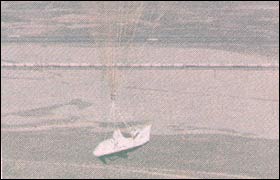NASA tested an automatic rescue vehicle to rescue the occupants of the space station in the event of an emergency

The space rescue vehicle in the parachute phase, when it behaves like a glider. Photo: Courtesy of Wind-River
The project to build and equip the International Space Station (ISS) - the largest joint scientific project in history (16 countries) is in progress, but the US space agency, NASA, is also preparing for the possibility after the launch of the station and the start of its regular operations, probably in In 2004, a technical malfunction or an extreme disaster could occur there, which would necessitate the urgent rescue of the scientists staying there and their immediate return to Earth. And this, when there is not enough time to organize for this purpose the launch of an organized space shuttle.
For this reason, a special automatic rescue vehicle was designed and built, which has just been launched. It was designed as an airtight cell, a large capsule. There is an intention to attach it as a "rescue boat" to the space station itself. In an emergency, the station occupants will enter the cabin and return to Earth.
In a test last month, at Edwards Air Force Base in California, the space shuttle proved its full effectiveness. He received the designation - X38, perhaps also a hint to the family of modern aircraft, the X that the USA is building now (like the X33).
The technology behind the new space vehicle is the "story". This is a real breakthrough: all its sophisticated systems are based on real-time operating systems developed by the scientists of the Californian "Wind River" company.
NASA, which is tight on its budgets, has now decided, unlike in the past, to rely on a system already in use by dozens of technology companies in the world - ranging from home and communication equipment manufacturers such as Sony, Cisco and Siemens to aerospace system manufacturers such as Rockwell and Raytheon - and to adapt it to the needs established in the project. The result: the capsule was built at record speed and at an extremely low cost.
The X38 looks like a scaled-down and refined version of a space shuttle. According to the planning, it will be attached to the outer part of the space station and will be used as a "rescue boat" for emergency situations that require emergency abandonment.
In such a case, the crew will enter the capsule, close its door, press an activation button - and from then on, all the operation of the vehicle will be automatic, thanks to the smart systems and the array of software in it - without the need for the passengers' intervention (assuming that the space scientists who are on the station are not trained as pilots). Without this method, they would not have been able to fly the vehicle on their own, back to Earth.
The VxWorks operating system developed by "Wind-River" for the X38 had extremely high requirements. This craft must fly as a spacecraft; When moving into the atmosphere to function as an airplane and at a certain stage, as determined in advance, a special parachute should open and the vehicle will act as a glider.
John Mo Ratura, X38 project manager at NASA: "This means that we will have to fly the capsule in many different and changing configurations. In every configuration many regular events occur, at a very high speed. This is why the operating system is so critical."
The test flight proved the rescue vehicle's ability to meet all its tasks. "If the operating system and the computer system of the flight did not perform the work in the way they were programmed in the laboratory and tested in ground conditions, we might lose the test vehicle or the person in it, in an operational state."
In the test flight, the X38 was attached to the belly of the giant B52 bomber which released it at an altitude of 13 km from the ground. The X38 performed a smooth glide as it aimed to land on the runway at Edwards Base.
Jerry Fidel, founder of the "Wind River" company that designed the system, flew with the bomber team that released the capsule in space.
The VxWorks system is responsible for all aspects of the flight and the precise operation of the communication and life systems in the space rescue vehicle. Wind River, headquartered in Almada, California (a regional support and training center in Israel) saw the project as a tremendous technological challenge - and won a "stamp" because NASA recognized its high reliability.
Fiedler, a former professional musician and one of the most respected people in Silicon Valley, is coming to Israel today; He will lecture tomorrow at a technology conference on "the future of embedded computer systems".
A.D.M
https://www.hayadan.org.il/BuildaGate4/general2/data_card.php?Cat=~~~330398527~~~9&SiteName=hayadan
